Autophagy: a novel mechanism of synergistic cytotoxicity between doxorubicin and roscovitine in a sarcoma model
- PMID: 18829554
- PMCID: PMC2561224
- DOI: 10.1158/0008-5472.CAN-08-1333
Autophagy: a novel mechanism of synergistic cytotoxicity between doxorubicin and roscovitine in a sarcoma model
Abstract
Doxorubicin is a genotoxic chemotherapy agent used in treatment of a wide variety of cancers. Significant clinical side effects, including cardiac toxicity and myelosuppression, severely limit the therapeutic index of this commonly used agent and methods which improve doxorubicin efficacy could benefit many patients. Because doxorubicin cytotoxicity is cell cycle specific, the cell cycle is a rational target to enhance its efficacy. We examined the direct, cyclin-dependent kinase inhibitor roscovitine as a means of enhancing doxorubicin cytotoxicity. This study showed synergistic cytotoxicity between doxorubicin and roscovitine in three sarcoma cell lines: SW-982 (synovial sarcoma), U2OS-LC3-GFP (osteosarcoma), and SK-LMS-1 (uterine leiomyosarcoma), but not the fibroblast cell line WI38. The combined treatment of doxorubicin and roscovitine was associated with a prolonged G(2)-M cell cycle arrest in the three sarcoma cell lines. Using three different methods for detecting apoptosis, our results revealed that apoptotic cell death did not account for the synergistic cytotoxicity between doxorubicin and roscovitine. However, morphologic changes observed by light microscopy and increased cytoplasmic LC3-GFP puncta in U20S-LC3-GFP cells after the combined treatment suggested the induction of autophagy. Induction of autophagy was also shown in SW-982 and SK-LMS-1 cells treated with both doxorubicin and roscovitine by acridine orange staining. These results suggest a novel role of autophagy in the enhanced cytotoxicity by cell cycle inhibition after genotoxic injury in tumor cells. Further investigation of this enhanced cytotoxicity as a treatment strategy for sarcomas is warranted.
Figures
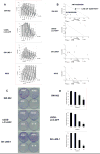
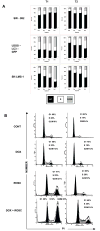
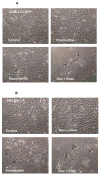
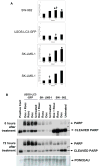
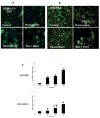

Similar articles
-
The effects of the CDK inhibitor seliciclib alone or in combination with cisplatin in human uterine sarcoma cell lines.Gynecol Oncol. 2007 May;105(2):462-9. doi: 10.1016/j.ygyno.2007.01.004. Epub 2007 Feb 14. Gynecol Oncol. 2007. PMID: 17300833
-
Roscovitine modulates DNA repair and senescence: implications for combination chemotherapy.Clin Cancer Res. 2005 Nov 15;11(22):8158-71. doi: 10.1158/1078-0432.CCR-05-1042. Clin Cancer Res. 2005. PMID: 16299248
-
Inhibition of autophagy by 3-MA potentiates purvalanol-induced apoptosis in Bax deficient HCT 116 colon cancer cells.Exp Cell Res. 2014 Oct 15;328(1):87-98. doi: 10.1016/j.yexcr.2014.07.022. Epub 2014 Aug 1. Exp Cell Res. 2014. PMID: 25088259
-
Seliciclib (CYC202; r-roscovitine) in combination with cytotoxic agents in human uterine sarcoma cell lines.Anticancer Res. 2007 Jan-Feb;27(1A):273-8. Anticancer Res. 2007. PMID: 17352243
-
Seliciclib (CYC202, R-roscovitine) enhances the antitumor effect of doxorubicin in vivo in a breast cancer xenograft model.Int J Cancer. 2009 Jan 15;124(2):465-72. doi: 10.1002/ijc.23938. Int J Cancer. 2009. PMID: 19003963
Cited by
-
Withaferin A synergizes the therapeutic effect of doxorubicin through ROS-mediated autophagy in ovarian cancer.PLoS One. 2012;7(7):e42265. doi: 10.1371/journal.pone.0042265. Epub 2012 Jul 30. PLoS One. 2012. PMID: 22860102 Free PMC article.
-
Potentiation of in vitro and in vivo antitumor efficacy of doxorubicin by cyclin-dependent kinase inhibitor P276-00 in human non-small cell lung cancer cells.BMC Cancer. 2013 Jan 23;13:29. doi: 10.1186/1471-2407-13-29. BMC Cancer. 2013. PMID: 23343191 Free PMC article.
-
A novel interaction between HER2/neu and cyclin E in breast cancer.Oncogene. 2010 Jul 8;29(27):3896-907. doi: 10.1038/onc.2010.151. Epub 2010 May 10. Oncogene. 2010. PMID: 20453888 Free PMC article.
-
PNUTS knockdown potentiates the apoptotic effect of Roscovitine in breast and colon cancer cells.Int J Oncol. 2010 May;36(5):1269-75. doi: 10.3892/ijo_00000611. Int J Oncol. 2010. PMID: 20372802 Free PMC article.
-
Roscovitine in cancer and other diseases.Ann Transl Med. 2015 Jun;3(10):135. doi: 10.3978/j.issn.2305-5839.2015.03.61. Ann Transl Med. 2015. PMID: 26207228 Free PMC article. Review.
References
-
- Zahm SH, Fraumeni JF., Jr The epidemiology of soft tissue sarcoma. Semin Oncol. 1997;24:504–14. - PubMed
-
- Gaynor JJ, Tan CC, Casper ES, et al. Refinement of clinicopathologic staging for localized soft tissue sarcoma of the extremity: a study of 423 adults. J Clin Oncol. 1992;10:1317–29. - PubMed
-
- Singer S, Demetri GD, Baldini EH, Fletcher CD. Management of soft-tissue sarcomas: an overview and update. Lancet Oncol. 2000;1:75–85. - PubMed
-
- Verweij J, Lee SM, Ruka W, et al. Randomized phase II study of docetaxel versus doxorubicin in first- and second-line chemotherapy for locally advanced or metastatic soft tissue sarcomas in adults: a study of the european organization for research and treatment of cancer soft tissue and bone sarcoma group. J Clin Oncol. 2000;18:2081–6. - PubMed
Publication types
MeSH terms
Substances
Grants and funding
LinkOut - more resources
Full Text Sources
Medical

